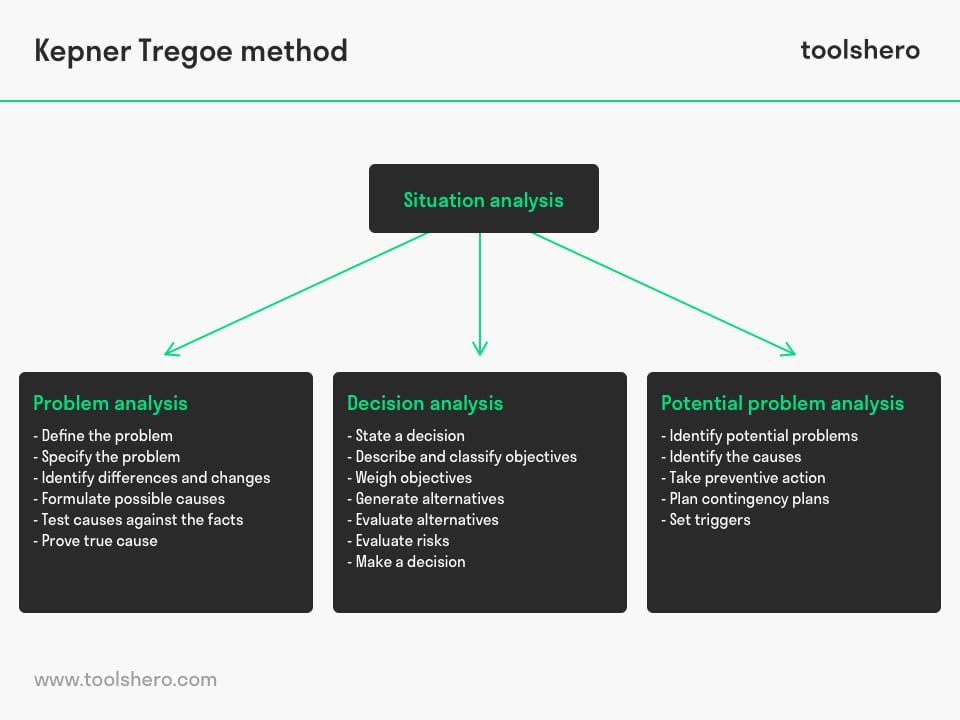Kepner Tregoe Method of Problem Solving

Kepner Tregoe Method of Problem Solving: this article explains the Kepner Tregoe Method, also known as the KT-method, developed by Charles Kepner and Benjamin Tregoe in a practical way. Next to what this is, this article also highlights rational processes, the importance of cause and that this method is effective. After reading, you’ll have a basic understanding of this problem solving process. Enjoy reading!
What is the Kepner Tregoe Method?
Problems occur in any given organization. Often there is pressure of time to solve the problems and it is debatable what the right way of solving these problems is.
The Kepner Tregoe method or KT-method is a problem analysis model in which the “problem” is disconnected from the “decision”. An English synonym for this problem solving method is Problem Solving and Decision Making (PSDM).
Traditional thinking pattern
The founders Charles Kepner and Benjamin Tregoe developed a rational working method in the 1960s in which they researched and identified the troubleshooting skills of people.
Throughout the centuries mankind has learned to deal with complexity and to (directly) anticipate on this. As a consequence, the traditional thinking pattern became a part of human nature.
When solving problems people search for the answer to the following four questions:
- What happened?
- Why did it happen?
- How should we act?
- What will be the (future) result?
Kepner Tregoe method: rational processes
To break through this traditional pattern Charles Kepner and Benjamin Tregoe came up with four rational processes in which four fundamental questions are reflected:
1. Situation analysis
This clarifies the problem situation (what happened).
1.1 Problem analysis
Here the actual cause of the problem and the relationship between cause and result are searched for (why did it happen).
1.2 Decision analysis
Based on the decision making criteria, choices are made to arrive at potential problem resolutions (how should we act).
1.3 Potential Problem analysis
Here potential future problems are anticipated and preventative actions are developed (what will the result be).

Figure 1 – Kepner Tregoe Method Analysis
Distinction
According to the KT-method, different tasks involve different problems, which in turn need different approaches. A situation analysis will clarify the distinctions in all these processes and as a result it will be possible to search for suitable solutions. This situation analysis provides an insight into necessity, priority and urgency of the various tasks.
When it has become clear which tasks are to be prioritized (action list) preparations can be made for potential problems. By using a good problem analysis in advance, a process will be created to prevent future problems or in emergencies, to limit the damage.
Cause
The strengths of this method does not stop there. Apart from the fact that problems are specified in terms such as “what, where, when and how big”, the Kepner Tregoe Method focuses on anything that cannot be the cause of the problem.
Certain causes are therefore excluded. Based on a “this is” and “this is not” analysis a clear overview of possible causes can be created and this makes the troubleshooting process consistent.
The Kepner Tregoe Method is efficient
The KT-method deploys an efficient troubleshooting process. Through research Charles Kepner and Benjamin Tregoe discovered that the registration of a problem is not a uniform process. In spite of the available information, people usually process information badly, misinterpret this or overlook important matters.
In addition, Charles Kepner and Benjamin Tregoe examined the discrepancies between successful and less successful troubleshooting.
They discovered that a predetermined logical method facilitates the search for the causes of a problem. In their “Best practice in troubleshooting”, they describe this methodology, which forms the basis for this method.
The Kepner Tregoe Method is Effective
This method is universal and is still used today in many organizations to track down problems and identify potential causes. Apart from the fact that the Kepner Tregoe Method leads to an explanation of problems, it also helps improve mutual understanding within an organization.
Moreover, it also helps improve clear communications with customer and suppliers, production quality, customer service and anything related to maintenance and repairs.
It’s Your Turn
What do you think? Is the Kepner Tregoe Method applicable in today’s modern organizations? Do you recognize the practical explanation or do you have more suggestions? What are your success factors for the good Kepner Tregoe Method set up?
Share your experience and knowledge in the comments box below.
More information
- Lussier, R. N. (2005). Management fundamentals: concepts. applications, skill development. Cengage Learning.
- Payne, S. L. & Marty, C.S. (1966). The Rational Manager: A Systematic Approach to Problem Solving and Decision Making. Journal of Marketing. Vol. 30 Issue 1, p97.
- Kepner, C. H. & Tregoe, B. B. (1965). The Rational Manager. McGraw-Hill.
How to cite this article:
Mulder, P. (2012). Kepner Tregoe Method. Retrieved [insert date] from Toolshero: https://www.toolshero.com/problem-solving/kepner-tregoe-method/
Original publication date: 06/30/2012 | Last update: 12/09/2023
Add a link to this page on your website:
<a href=”https://www.toolshero.com/problem-solving/kepner-tregoe-method/”>Toolshero: Kepner Tregoe Method</a>













4 responses to “Kepner Tregoe Method of Problem Solving”
I am stunned to read that the Kepner Tregoe Method “…… IS STILL used today in many organizations to track down problems and identify potential causes…..”. I have used it all the time along my career as a manager of organizations, with extreme success. As a tool for identifying problems, as a tool for taking better decisions. So, please, I would appreciate to know what kind of system is being used now instead of an approach like K-T, to have provoked your comment about the existence of an alternative way of thinking.
Other than KT, I also use the Analytic Hierarchy Process (AHP) Like KT, it forces discipline and analysis and it helps to explain why decisions are made with understandable background and data. Many of the old Total Quality Management tools are also useful for solving problems and making good management decisions. Nominal Group Technique, Pareto Charts, and weighted multivoting are all quite useful. ITIL is the new way of thinking, but it can be rather dry and robotic unless it is underpinned with good decision tools.
Thank you for your comment and sharing your experience Pete.
Seems that I naturally deal with problems this way without knowing a name for it. In fact, it seems obvious to me that this approach should be taken anyway.